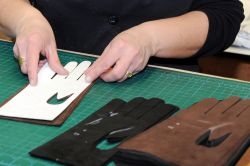Luxury, ancient craft go hand in glove in French town

Chanel, Dior, Hermes, Louis Vuitton: the top names in world fashion go to Millau for their gloves, tapping into a manufacturing tradition that stretches back to the 12th century and peaked a hundred years ago.
Worn long for elegance, fingerless by sportswomen, made of lambskin for suppleness, python or iguana for an exotic touch, in scented leather or covered in cockerel feathers for collectors, gloves have been making a comeback on the catwalks.
„Our philosophy is to create gloves that are worn like jewellery,“ said Manuel Rubio, general manager of glove-maker Causse, acquired last September by Chanel as part of a strategy of buying up high craft suppliers in France and Europe.
Founded in 1892, Causse was then one of 80 tanneries and 20 glove-makers that employed some 7,000 people in and around Millau, turning out about four million pairs of gloves each year, recalls the Millau and Grandes Causses Museum curator Francois Leyge.
For Millau could — and can still — draw on a key raw material: the hides of millions of lambs whose mothers were reared for their milk on the nearby Larzac plateau.
In a bygone age, the town’s glovemakers prospered thanks to the extravagant tastes of Queen Marie-Antoinette or the Empress Josephine, who was known to order up to 985 pairs in a single year.
During the French Belle Epoque (Beautiful Era), from the 1870s to the outbreak of World War I, it was unthinkable for a well-heeled man or woman to leave home without gloves — a convention that held pretty much until the 1960s.
But come the student revolts of May 1968, and fashion codes radically changed — with a denim-clad younger generation preferring neckscarves or jewels as accessories.
Combined with rising manufacturing costs in an industry where much of the work is still done by hand, the changing times near-decimated Millau glove-making.
— ‚Each house has its universe‘ —
Nearly but not quite. Today, there are four tanneries and as many glove-makers left.
The largest of them, Causse, employs 42 people in a little workshop designed by star French architect Jean-Michel Wilmotte, turning out some 25,000 pairs a year.
Fellow Millau glove-maker Fabre, which supplied Grace Kelly via the house of Christian Dior, is also behind the gloves worn by Nicole Kidman in the upcoming biopic „Grace de Monaco“.
The other two are Lavabre-Cadet — beloved of the fictional gentlemen thief Arsene Lupin — and the Atelier du gantier, which today turns out a small, playful line.
All owe their continued existence to the luxury industry, which put gloves back on the catwalks from the 1990s onwards.
Couture houses make for demanding customers, explains Nadine Carel, artistic director at Causse.
„Each house has its universe, and you have to learn to work within their codes,“ she said.
A high fashion order rarely goes beyond a hundred pairs, with collections sometimes updated several times a year — unworkable constraints for an industrial glove-maker.
Causse sells under its own brand as well as producing for the catwalks, working fur or metal embellishments onto its gloves, or teaming up with graffiti artists — for a price tag that can soar to 3,000 euros ($4,000) a pair.
Among its loyal customers it boasts style icons from Madonna and Kylie Minogue to Sharon Stone, as well as Chanel’s flamboyant designer Karl Lagerfeld, who relies on the house for his signature studded fingerless black gloves.
„These days, people wear gloves as style thing,“ summed up Rubio. „They are a fashion object — a way of making yourself stand out. Keeping out the cold comes in distant second place.“
gcv/ec/mlr

